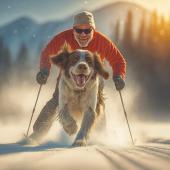Battling the Bite
And avoiding other winter hazards.
For outdoor enthusiasts and their pets, Montana winters are magical. However, they’re also filled with hazards, especially as temperatures drop. Frostbite is a common problem, and one we can avoid. It can affect almost any mammal during cold weather, most commonly the ears, muzzles, tails, and feet, all areas away from the heart and body core. When the body starts to cool down, blood vessels near the surface and in the extremities constrict to keep blood flow closer to the core, near important organ systems. The reduced blood flow and cold temperatures cause body tissue in these outer areas to freeze, leading to tissue injury.
Signs that your pet has frostbite may appear several days after initial exposure, and may include discoloration of the skin. Affected areas often start to turn gray or bluish and feel cold and hard to the touch. They can appear reddened and swollen as the skin and tissues warm and thaw, forming blisters on the surface in extreme cases. This can be very painful for your pet, and can progress to black, necrotic (dead) skin and tissues which can become infected and require amputation.
If you suspect frostbite, seek veterinary attention immediately. Slowly warm your pet using blankets or towels and bring her into a warm, dry environment. Don’t rub the suspected areas in an attempt to warm them; instead, soak them using warm water at a temperature where you can comfortably run it over your hand (about 106 degrees). Keep affected areas continuously warm, avoiding additional exposure to the cold. Once at the vet hospital, your pet will likely be assessed for shock or hypothermia and will be put on pain medications. To prevent frostbite in your pets, always ensure that they have a warm, dry place to go during cold weather.
Another winter hazard is antifreeze. While there are many newer forms of “pet-safe” antifreeze available for use, poisoning from traditional ethylene glycol–containing antifreeze is still common. It takes only three ounces of ethylene glycol to poison a medium-sized dog.
Ethylene glycol is very attractive to animals, but it poisons the kidneys, liver, and brain. Signs of ethylene-glycol toxicity include weakness or depression; a wobbly, “drunken” gait; rapid heartbeat; vomiting or diarrhea; loss of appetite; excessive urination; seizures, muscle tremors, or convulsions; and fainting or coma. Time is critical. Your veterinarian will need to do diagnostic testing of blood and urine, and your pet may need to stay in intensive care for the antidote and additional treatments to prevent kidney failure. Even a small amount of ethylene glycol can cause kidney failure in a pet within days.
Use pet-safe antifreeze only. Any traditional antifreeze should be labeled and kept in a secured container at all times. Monitor vehicles for radiator leaks and clean up spills immediately. Pay attention to signs of leaks at popular trailheads and parking lots. Prevent your pet from wandering or otherwise having access to areas where they may access antifreeze.
Chemical de-icers are another item of concern. De-icers are most commonly made up of salts such as sodium chloride, magnesium chloride, potassium chloride, calcium carbonate, calcium chloride, and calcium magnesium acetate. If ingested, these can cause gastrointestinal problems (ranging from loss of appetite to severe nausea, or even bloody vomit or diarrhea). Some signs of ingestion are increased thirst and urination, wobbly gait, mental confusion, or even coma, seizures, or death in more advanced cases.
De-icers can also cause chemical burns to skin or paws. Paw pads may dry and crack, or become chapped. Use salves or waxes specifically designed for pets’ paws and keep fur between toes trimmed to prevent ice build-up. If your dog does come into contact with de-icer, thoroughly wipe down her paws and skin and prevent her from licking those areas.
To protect your pet from de-icers, avoid places where they’ve been used and use pet-friendly de-icers at home. Prevent your dog from eating snow or drinking from puddles in areas that may have been treated. If you suspect your pet has ingested de-icer, call your veterinarian immediately.
Winter can be enjoyable for us and our pets, but because of weather-specific risks, it is important to be vigilant. Keep an eye out for contaminants and during extremely low temperatures, keep your pets indoors.
Dr. Julie Oghigian is a Bozeman veterinarian, veterinary columnist, and outdoor enthusiast.










